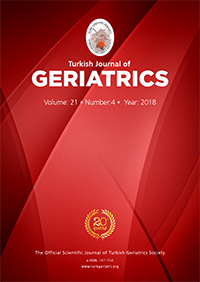2Kafkas University, Faculty of Medicine, Department of Public Health, Kars, Turkey DOI : 10.31086/tjgeri.2018.54 Introduction: We determined influenza, pneumococcal and herpes zoster vaccination rates amongst people aged ?65 years and evaluated factors affecting the vaccination rates.
Materials and Method: The vaccination rates were investigated using face-to-face interview in 543 patients aged ?65 years who were admitted to the internal medicine outpatient clinics of Kafkas University School of Medicine and public hospitals in the 30th health service area. Subjects were divided into two groups: vaccinated and unvaccinated. Vaccination status was the dependent variable; knowledge of vaccination and socioeconomic and sociodemographic characteristics were the independent variables.
Results: The number of unvaccinated subjects was 6.6 times higher amongst participants with no knowledge of vaccination than amongst those with knowledge of vaccination (95% confidence interval, 2.9?14.9, p=0.001), 2.6 times higher amongst participants with no primary education than amongst those with primary education (confidence interval, 1.5?4.5, p=0.001), 2.7 times higher in participants with insufficient income than amongst those with sufficient income (confidence interval, 1.2?5.9, p=0.006) and 2.2 times higher amongst participants living in rural areas than amongst those living in urban areas (confidence interval, 1.2?3.7, p=0.006). These were the factors affecting the vaccination status in the elderly.
Conclusion: Additional solutions are required to encourage physicians and other healthcare providers to provide the elderly with information and encourage them to be vaccinated as recommended by the "Centre for Disease Control and Prevention", increasing the vaccination rates amongst those living in villages and rural areas and with low income.
Keywords : Aged; Influenza vaccines; Pneumococcal vaccines; Herpes Zoster vaccine
